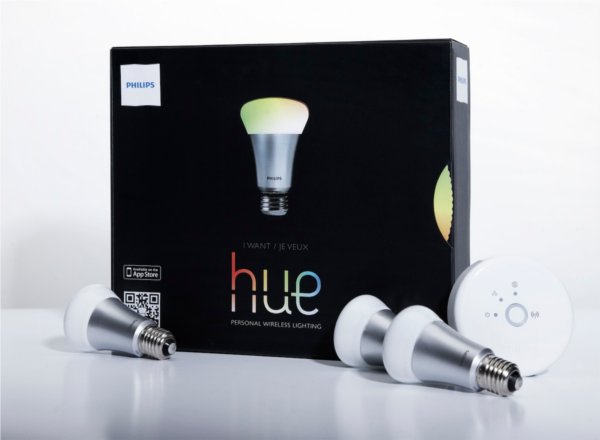Colored LED lighting that could be remotely controlled used to take professional installation and thousands of dollars; now, Philips’ new hue system makes it as easy as screwing in a bulb. On sale – initially exclusively through Apple Stores – the hue bulbs screw into a regular ES fitting and are remotely controlled from iOS or Android apps over a ZigBee connection, either locally around the home or (handy if you’ve left the lights on while you’re on holiday) anywhere with an internet connection.

The starter box – containing three bulbs and the base station – is priced at $199/£179, while individual bulbs are priced at $59/£49. That might seem expensive on the face of it (though Philips has high-end white LED bulbs in its range that are $50-60 alone) but, in comparison with the LivingColors lamps which come in with an RRP of £159 apiece, it starts to look more reasonable.
Installation is simple: screw in the bulbs, plug the ZigBee base station into a spare ethernet port on your router, and hook it up to the mains. A pairing button on the base station allows you to link up any other hue bulbs, while three LED lights show system status including whether there’s an internet connection for remote access. Since ZigBee is a mesh system, each hue bulb can talk to each other: bulbs can be a great distance from the base station itself, just as long as there are other bulbs spanning the intermediate distance.
The bulbs themselves use 8.5W at most, and – at 600 lumens – are equivalent to 50W traditional bulbs. They also use a special internal coating that, coupled with the shape of the glass, projects light more evenly around the bulb, meaning there isn’t a dead-zone to your lamp. Officially, up to 50 can be paired with a single base station, though Philips told us that in fact that’s more of a quality-assurance guarantee; in fact, the company has had 250+ bulbs paired with test systems, and had no real issues with them. Bayonet fitting versions are in the pipeline.
Control is via smartphone and tablet app, with iPhone, iPad, and Android versions available at launch; up to ten devices can be linked to control any one base station. The software itself is surprisingly comprehensive. At its most basic, you can adjust the color of any one bulb across the spectrum, including adjusting brightness and color temperature, from a rich red, deep blue, bright white, or anything in-between. You can link up two or more bulbs into a group, and control them all simultaneously, and create preset scenes which each have their own icon on the app’s homescreen.
However, there’s also color sampling to be played with. Philips includes a number of photos in the app – scenes like beaches or mountains – and by dragging pointers linked to each lamp, you can recreate the color of that point in the image.
Finally, though, comes Philips’ splash of science. The company preloads four “LightRecipes” – relax, read, concentrate, and energize – which adjust lighting to specific shades and brightness levels based on research into how those scenarios affect the human body. Philips says testing in schools showed students did better in tests, were calmer, or read faster and more accurately, depending on the different setting active at any one time.
Perhaps best of all, it’s all designed to be open. Philips’ base station works as a regular ZigBee hub, and so will function with any other ZigBee devices that conform to the standard, while the individual bulbs are compliant with the ZigBee Light Link standard and so can be integrated with wireless home automation setups you might have already. The company is also opening up its app to third-party developers, in the hope that they’ll step in and augment the functionality. Suggestions included flashing the lights when you get a VIP email, synchronizing color changes with musical playlists, or geo-location so that the lights automatically turn on when you get home, and off when you leave.
